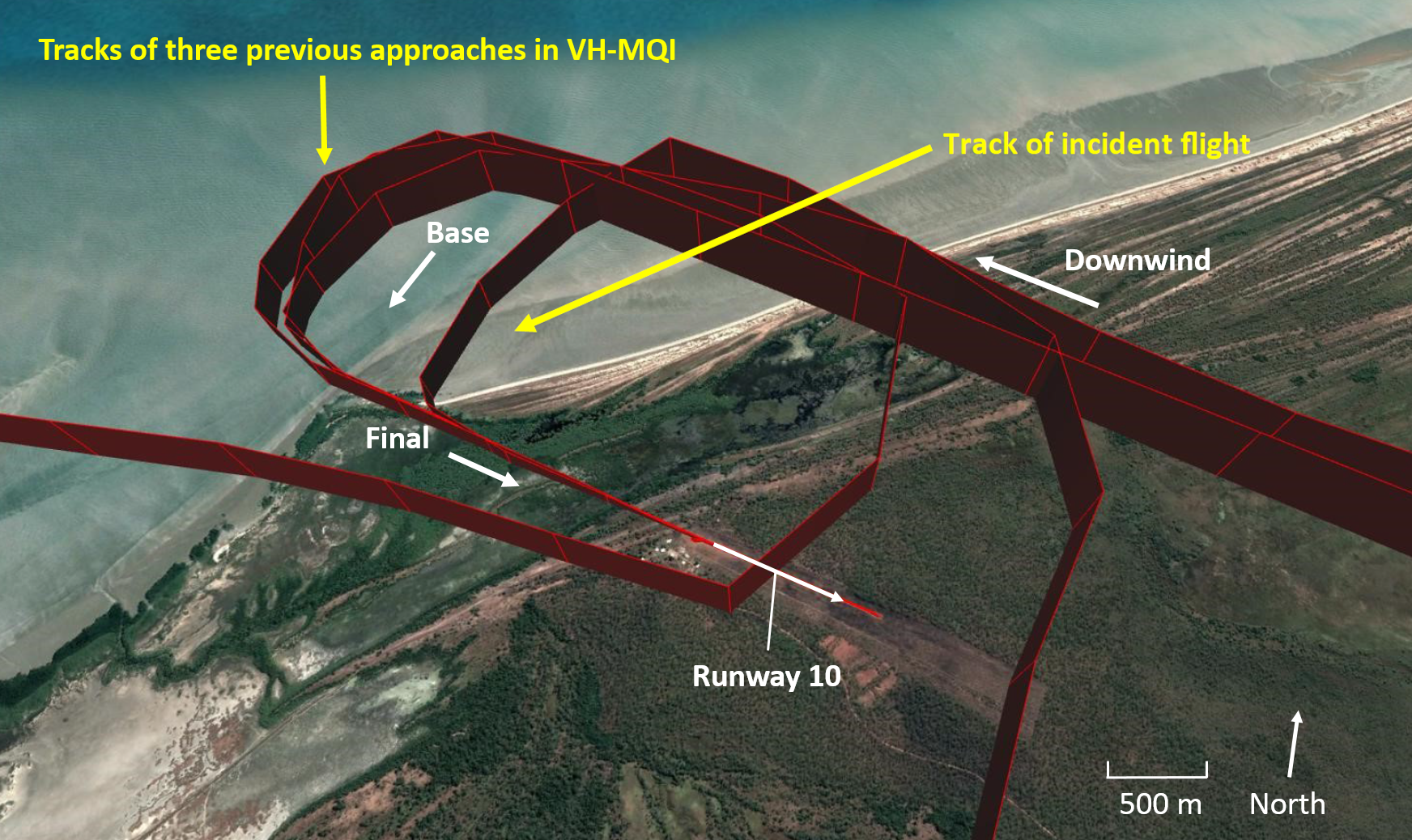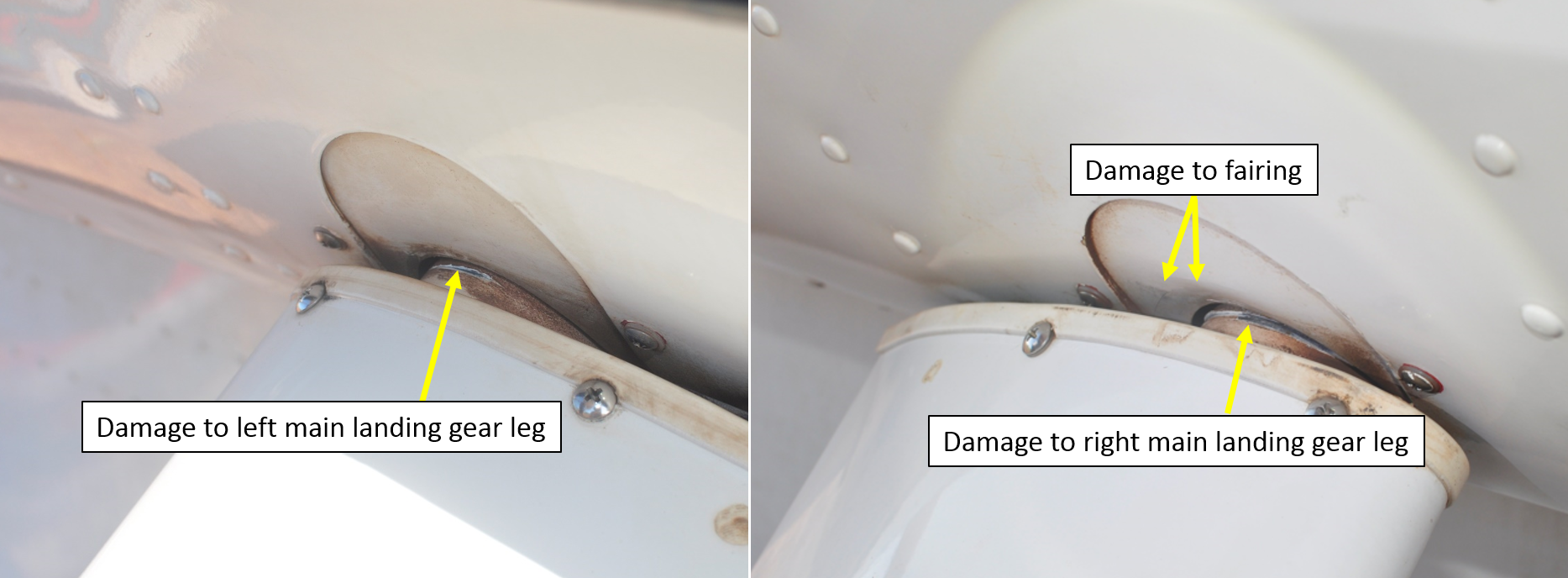What happened
On 2 August 2017, a Gippsland Aeronautics GA-8 aircraft registered VH-MQI, was operated by Arnhem Land Community Airlines, as a charter passenger flight from Milingimbi, Northern Territory (NT) to Djamardi aeroplane landing area (ALA),[1] NT. There was a pilot and five passengers on board.
At about 1225 Central Standard Time (CST), the aircraft joined the downwind leg of the circuit for runway 10 at Djamardi. The pilot observed the windsock indicating a light north-easterly wind.
Recorded data captured the incident approach, along with three previous approaches, conducted by VH-MQI to runway 10 during earlier flights to Djamardi. The data shows that on the incident approach, the aircraft turned onto the base leg of the circuit earlier than these three previous approaches (Figure 1).
After turning onto the base leg, the pilot believed the aircraft was becoming high on the desired approach path and reduced power to return to the desired path. After turning onto the final leg of the circuit, the pilot stabilised the aircraft at the selected approach speed of 65 kt with a rate of descent of about 500 feet per minute.
Figure 1: Representation of recorded data showing the tracks of four approaches, including the incident approach, made by VH-MQI to runway 10 at Djamardi ALA. The downwind, base and final legs of the circuit for runway 10 are also shown.

Source: Operator, annotated by ATSB
At about 1227 as the aircraft approached the runway at a height of about 50 ft, the pilot observed the airspeed reduce to 62 kt and lowered the nose to accelerate the aircraft. The pilot did not recall increasing power. Recorded data shows that at this time, the descent rate increased to 846 feet per minute. The pilot detected the increasing descent rate and flared the aircraft more positively than normal, however he was unable to arrest the rate of descent. The aircraft touched down hard on the main landing gear. The cargo pod (Figure 2) struck the runway.
After the aircraft touched down hard, the aircraft bounced and became airborne. The pilot then increased power to attempt to stabilise the aircraft and continue the landing. The aircraft then touched down a second time, on the nose landing gear first, and again bounced. The pilot further increased power, stabilised the aircraft, and landed.
The pilot and passengers were not injured in the incident, the aircraft sustained minor damage.
Figure 2: VH-MQI showing the cargo pod fitted to the aircraft (left) and damage sustained during the incident (right).

Source: Operator, annotated by ATSB
Pilot comments
The pilot of the aircraft made the following comments:
- In response to the reducing airspeed, instead of lowering the nose, power should have been increased.
- Prior to landing, the approach did not feel out of control, or overly unusual. Only when the aircraft landed hard did he realise that it was an abnormal situation.
Operator report
The operator of the aircraft conducted an investigation in to the incident and provided the following observations:
- The early base turn led to a steeper approach descent profile.
- A change in wind direction from a north-easterly, to a northerly as the aircraft approached the runway, combined with mechanical turbulence caused by trees, increased the aircraft descent rate.
- After the pilot detected the reducing approach speed, the technique used to accelerate the aircraft was incorrect. Engine power should have been immediately increased.
- The cargo pod, both main landing gear legs and the fairings where the landing gear legs enter the fuselage were damaged (Figure 3). The right main landing gear leg was also cracked.
Figure 3: Damage to left main landing gear leg (left), and damage to the right main landing gear leg and fairing (right).

Source: Operator, annotated by ATSB
Safety analysis
Late in the final approach, the pilot detected the airspeed reduce below the desired speed. In response, the pilot lowered the nose of the aircraft. This led to a high descent rate which could not be arrested prior to the hard landing.
The hard landing damaged the cargo pod, the main undercarriage legs and fairings.
Findings
These findings should not be read as apportioning blame or liability to any particular organisation or individual.
- The incorrect response to the reducing airspeed led to a high descent rate with insufficient height to recover. This resulted in the hard landing and aircraft damage.
Safety action
Whether or not the ATSB identifies safety issues in the course of an investigation, relevant organisations may proactively initiate safety action in order to reduce their safety risk. The ATSB has been advised of the following proactive safety action in response to this occurrence.
Aircraft operator
As a result of this occurrence, the aircraft operator has advised the ATSB that they are taking the following safety actions:
Flight crew training
- The pilot has received training in the correct technique to arrest a high rate of descent during approach and landing.
Guidance material
- The operator’s guidance material for Djamardi ALA has been updated to include a note advising of possible turbulence due to the surrounding trees.
Safety message
This incident highlights the importance of maintaining the correct approach descent profile and speed, and ensuring that pilots respond correctly to any deviations from the desired profile.
The United States Federal Aviation Administration (FAA) Airplane Flying Handbook, chapter eight, Approaches and Landings contains the following guidance for pilots when approach speed reduces below the desired speed:
On the final approach, when the airplane is flown at a slower than normal airspeed, the pilot’s judgment of the rate of sink (descent) and the height of round out is difficult.
Whenever a slow speed approach is noted, apply power to accelerate the airplane and increase the lift to reduce the sink rate and to prevent a stall. This is done while still at a high enough altitude to re-establish the correct approach airspeed and attitude. If too slow and too low, it is best to execute a go-around.
Purpose of safety investigationsThe objective of a safety investigation is to enhance transport safety. This is done through:
It is not a function of the ATSB to apportion blame or provide a means for determining liability. At the same time, an investigation report must include factual material of sufficient weight to support the analysis and findings. At all times the ATSB endeavours to balance the use of material that could imply adverse comment with the need to properly explain what happened, and why, in a fair and unbiased manner. The ATSB does not investigate for the purpose of taking administrative, regulatory or criminal action. TerminologyAn explanation of terminology used in ATSB investigation reports is available here. This includes terms such as occurrence, contributing factor, other factor that increased risk, and safety issue. Publishing informationReleased in accordance with section 25 of the Transport Safety Investigation Act 2003 Published by: Australian Transport Safety Bureau © Commonwealth of Australia 2017
Ownership of intellectual property rights in this publication Unless otherwise noted, copyright (and any other intellectual property rights, if any) in this report publication is owned by the Commonwealth of Australia. Creative Commons licence With the exception of the Coat of Arms, ATSB logo, and photos and graphics in which a third party holds copyright, this publication is licensed under a Creative Commons Attribution 3.0 Australia licence. Creative Commons Attribution 3.0 Australia Licence is a standard form licence agreement that allows you to copy, distribute, transmit and adapt this publication provided that you attribute the work. The ATSB’s preference is that you attribute this publication (and any material sourced from it) using the following wording: Source: Australian Transport Safety Bureau Copyright in material obtained from other agencies, private individuals or organisations, belongs to those agencies, individuals or organisations. Where you wish to use their material, you will need to contact them directly. |
__________


